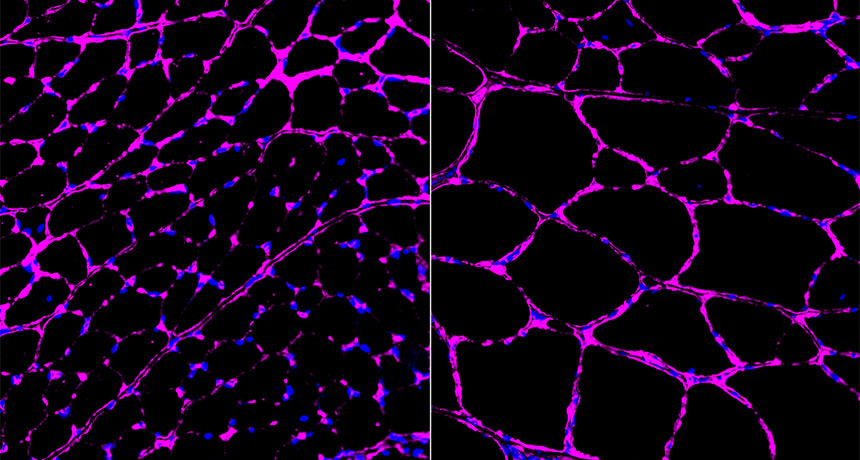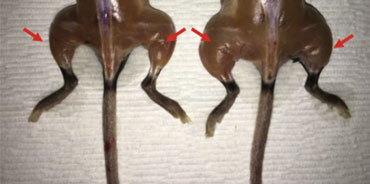CRISPR/Cas9 can reverse multiple diseases in mice
New use for the genetic tool turns genes on instead of snipping them

PUMP IT UP A new type of CRISPR/Cas9-based gene therapy turned on muscle-building genes in mice that have muscular dystrophy. Muscle fibers (magenta) from mice that got the therapy (right) were bigger than fibers from untreated animals (left).
H.-K. Liao et al/Cell 2017
- More than 2 years ago
A new twist on gene editing makes the CRISPR/Cas9 molecular scissors act as a highlighter for the genetic instruction book. Such highlighting helps turn on specific genes.
Using the new tool, researchers treated mouse versions of type 1 diabetes, kidney injury and Duchenne muscular dystrophy, the team reports December 7 in Cell. The new method may make some types of gene therapy easier and could be a boon for researchers hoping to control gene activity in animals, scientists say.
CRISPR/Cas9 is a two-part molecular scissors. A short, guide RNA leads the DNA-cutting enzyme Cas9 to specific places in the genetic instructions that scientists want to slice. Snipping DNA is the first step to making or fixing mutations. But researchers quickly realized the editing system could be even more versatile.
In the roughly five years since CRISPR/Cas9 was first wielded, researchers have modified the tool to make a variety of changes to DNA (SN: 9/3/16, p. 22). Many of those modifications involve breaking the Cas9 scissors so they cannot cut DNA anymore. Strapping other molecules to this “dead Cas9” allows scientists to alter genes or change the genes’ activities.
Gene-activating CRISPR/Cas9, known as CRISPRa, could be used to turn on dormant genes for treating a variety of diseases. For instance, doctors might be able to turn on alternate copies of genes to compensate for missing proteins or to reinvigorate genes that grow sluggish with age. So far, researchers have mostly turned on genes with CRISPRa in cells growing in lab dishes, says Charles Gersbach, a biomedical engineer at Duke University not involved in the new study.
Being able to precisely turn on genes within an animal and influence the animal’s health is a “great advance,” Gersbach says. It has been difficult to do before because CRISPR activators are too big to fit inside viruses needed to deliver the tools to body cells.
In the new study, Juan Carlos Izpisua Belmonte of the Salk Institute for Biological Studies in La Jolla, Calif., and colleagues shrank the tool. This time, the researchers “killed” and modified the guide RNA instead of the DNA-cutting enzyme. The team used short guide RNAs, just 14 or 15 units long, instead of the usual 20 to 22.

The short leash can still lead Cas9 to specific spots in DNA, but once there, the enzyme — although still capable of cutting — doesn’t snip the DNA. Another piece of RNA tacked onto the “dead” guide attracts proteins that help turn genes on. The pieces of the dead guide activators are small enough to fit in gene therapy viruses.
In one experiment, the team wanted to restore the ability of mice with a version of type 1 diabetes to make insulin, a hormone that controls blood sugar. In type 1 diabetes, the immune system destroys the pancreas, the organ that normally makes insulin. Since pancreatic cells are gone, the researchers needed a new type of cell to take over the pancreas’s job.
So Belmonte’s group infected diabetic mice with viruses carrying the dead guide activators. The researchers used the dead guide RNAs to turn on the Pdx gene in the mice’s livers, which caused the liver cells to produce insulin, reversing the mice’s diabetes. Essentially the liver cell was transformed into one that does an important job of the pancreas.
“Labs have been trying to do that for decades,” says Kirk Wangensteen, a physician scientist at the University of Pennsylvania Perelman School of Medicine. Such experiments will help scientists understand what factors determine a cell’s identity.
But to do the gene therapy in humans, scientists would need to tackle another problem. In the diabetes experiment, they could use mice already engineered to make their own Cas9. But people don’t naturally make Cas9, and the entire dead guide activator and Cas9 system won’t fit in a single virus. So Belmonte’s team wanted to know if two viruses could be used at once to deliver all the pieces to target cells.
The Salk researchers tested their system in mice with a muscle-wasting disease that mimics Duchenne muscular dystrophy. Duchenne muscular dystrophy is caused by mutations in a huge gene called dystrophin. There’s no way to cram the dystrophin gene into a virus to do traditional replacement gene therapy, but researchers have found that turning on other genes can compensate and bulk up muscles. So in the dual-virus experiment, the scientists turned on a muscle-building gene called follistatin.
This time, the dead guide activator for turning on the follistatin gene was packaged in one virus and Cas9 in another virus. Both viruses were used to infect muscle cells in the hind legs of mice that had muscular dystrophy. Treated mice had more muscle mass in their hind legs than untreated mice did.
Much higher levels of gene activity were triggered in these experiments than scientists have achieved before, says Michael Hemann, a cancer biologist at MIT. High levels of activity are probably needed to produce enough protein to correct diseases.
Hemann and others say the new activator system will be useful for research, but some challenges remain before the therapy can be used in people. Researchers always have a challenge getting the therapy to the right place in the body, he says. The technology’s safety and efficacy must also be demonstrated.






